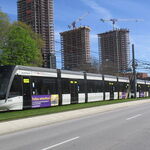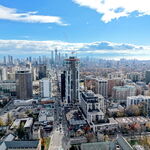Is there a reason that GO Stations are starting to look like airport terminals? Based on
this forecast ridership is only expected to be 3,500 by 2031?
3,500 daily riders is a
full freeway lane for 2 hours, or
two full peak-period freeway lanes at an average 2 seconds between cars. We build freeways to try to solve only that
ONE hour: Overkill, overkill, overkill -- very empty at 4:00 AM -- just to be clogged full at 5:00 PM. The cost of building one or two extra freeway lanes, in many cases,
is more expensive than the cost of of building the GO station. This is a two-track corridor capable of moving more people during peak hour than a 6-lane-freeway during peak hour, even if there's no offpeak service today. On this basis, it seems still money well spent, although I admit sometimes the station size seem slightly overkill. But it's a long-term building; 50+ year lifetime, 100+ year for really good quality buildings.
But it's also worth considering that
2031 is only something like 10 years away after guesstimated construction completion (thinking of delays, Burlington-style). Ridership could double beyond 2031, with appropriate expansions, for example. And Richmond Hill might be part of RER Phase II, who knows? That's still within the station's own lifetime. If it's good, then there will be no need to teardown and rebuild in 20 years. Some GO stations are old but nice -- such as the 1930s style Hamilton Downtown GO station. Build it well, it will last.
Spending priorities is a legitimate argument, for sure (which stations to build first, which lines to enhance first, resource assignment, etc). Maybe Bloomington was a bit early, overbuilt, too big, or at least only at first. Maybe not, I'm not familiar with that part of the GTHA region. But the above perspective helps.
And another consideration is what will Bloomington area looks like in 50 years -- developments, densification, etc. In an era of Richmond Hill 2-way service by the mid 21st century, we might even see a new small CBD pop up. Mississauga was practically farmland not that long ago...
It's the usual "Taxpayer waste today, big taxpayer revenues tomorrow" argument. All the new revenues from all the new commuters who now live in new profitable businesses/developments/etc as the areas of Bloomington grows. Goverments (any color) are so short sighted, to the point that Bloomington is a far-sighted development. Its mere existence helps justify and accelerate further GO expansions.
In fact, the cost of that GO station won't even build 100 meters of subway. 3,500 people served by the cost of Bloomington GO versus the cost of 2 more peak-period freeway lanes?
Continually as a car owner, I'm amazed and shocked how much money we spend on roads, even as a car driver, it's really, really eye opening. That 16-lane wide, over a one hour, 401 only carrying 1,700 cars per lane during peak period? And we spent all of that to build that, expand a lane, etc, just to save five to ten minutes per day of commute that quickly disappears in a couple years as developments expand??
Bloomington GO looks brilliant spending literally in comparison, even if it's bit too early/longerm for shortsighted governments and the politics of completing electrification (thankfully, electrification is now finally but assured, since shovels will occur before next election, and since all 3 levels of government is aligned despite minor nitpicking like academic smarttrack-versus-RER terminology). You know, large EMU/DMUs (large EMUs more likely) can double the number of people pushed per track corridor, so while stupendously expensive, it's like doubling the width of a freeway without doubling the physical width.
That's why electrification is so tempting, properly done, it massively increases capacity, especially if bottlenecks are worked on (e.g. USRC resignalling + reopen all still-closed Union tracks + doubleberthing west of York + shorter subway-style dwell time at Union + triple size GO concourse + six times the waiting space due to shopping mall underneath the whole Union footprint). Platform crowding will remain constant thanks to optimizations like the above, allowing twice the number of people will board trains during peak hour at Union -- without doubling the crowds per platform. Obviously, the new additional PATH connections all need to be fully open, so we have twice-the-number-total-meters-of-width of PATH openings into Union, than there was (I mathed it out: it comes to approximately double); so that Union pedestrian throughput can successfully double during peak. I'm impressed how much more Union is able to handle, once I completely analyze the theoretical post-megaproject numbers. I just wish they wouldn't dillydally on the USRC switch upgrades; it can push twice as many trains in-out of Union berths if upgraded to European standards or even just simply New York Penn standards. Penn station is roughly the same same number of tracks and platforms as Toronto Union, and would be roughly identical number of berths if including potential double-berths west of York. (Opposite-direction routes such as Milton-RichmondHill can easily double berth with no delays). Yet New York Penn (which is electric-only) is able to handle twice the number of peak-period commuters.
This is a stupendous GO megaprojects lasting a long time, and eventually a 4-track underground corridor will be needed somewhere (mentioned in the Metrolinx 2031 document from a few years ago). The silly SmartTrack/DRL tunnel talk is nothing new, as is the interesting UPX/SmartTrack/transit merger ideas, I just wish funding was a little more efficiently allocated more quickly; but any initiatives that expand the entire GO network into an all-day 2-way frequent (15-min-or-better) regional public transit network with good TTC/local connections (including
--yes-- future driverless cars) -- is all wholly welcome.
If RER electrification does not proceed, post-revitalization Union will be very empty during offpeak, and stores go bankrupt in the malls under Union. The Union expansion pretty much guarantees RER will happen, and our governments has now already aligned to make sure that happens.
If you look at the Bloomington Station plan as well it too seems grossly overbuilt for where it is and what it is. Maybe one of you can shed some light on why they seem to be building such gigantic stations now?
In the RER era, and all-day service on the entire GO service, we're pretty much doing a megaproject of upgrading GO into a bona-fide surface subway network (even if not as frequent as subways). Mega stations are a part of RER goals.
I must admit that the Richmond Hill line, which will won't be electrified this time, it's a bit of a big project as it will require raising the rails at least one meter higher to get above the Don River flooding level. But it could happen fairly early within the projected lifetime of the Bloomington GO station.












